Bikepacking the Ausangate Circuit in Peru was the perfect and hardest bikepacking journey I’ve achieved so far. It’s an epic route with unbelievable surroundings and different terrain. Examine my journey and be taught how one can plan your Ausangate journey!
I’ve achieved numerous bikepacking journeys, however the Ausangate Circuit in Peru was by far the toughest and most epic bikepacking journey I’ve achieved so far. It was unbelievable! (and extremely laborious…) However I LOVED it. The concept for this 5d/4n journey took place after a pal – Malcolm – and I accepted spots to work on the South American Epic. We knew we wished to do a pre-trip journey previous to becoming a member of the tour in Cusco, Peru, and the Ausangate Circuit seemed good. We did our planning, however I feel we each can agree now that it was extra lovely, tougher, and extra epic than we had anticipated.
The entire 40+ mile circuit is gorgeous with continuous views of snow-capped jagged peaks, turquoise blue alpine lakes, crackling glaciers, and wide-open llanos (plains) dotted with llamas and alpacas. It’s distant Andean wilderness at its most opulent.
However, as we realized, bikepacking the Ausangate Circuit can also be very difficult. The route is especially traveled by hikers and horses (if you happen to’re a mountain biker, you realize what meaning…) and the entire circuit is above 15,000 ft. Respiration and sleeping had been tough, to say the least.
The biking was additionally an uphill battle – actually! All the climbs had been hike-a-bikes, both due to the altitude (pedaling at 15k toes isn’t any joke y’all), the steepness of the climbs (my arms obtained extra of a exercise than I’d anticipated), or the rocky terrain (I like navigating rock gardens, however some stretches on the circuit are not possible to trip). I’d say we rode about 50% of the entire route and pushed our bikes for the opposite 50%. Exhausting? Sure. However value it? 100%.
Bikepacking the Ausangate Circuit is an unbelievable journey, however you undoubtedly have to do some planning and know what to anticipate earlier than trying it. The route is extremely distant, at excessive altitude, and bodily very demanding. If it’s a visit you’re contemplating, this information will provide you with all the information it’s essential assist plan your journey.
An enormous due to Haku Expeditions for serving to us make our journey attainable. They organized our bike leases and offered transport to and from the beginning of our journey from Cusco. In case you’re planning a DIY journey, attain out to them for assist with logistics. Or, if you wish to do a supported journey, they provide a 5-day Ausangate Mountain Bike Journey that appears superb and features a soak in sizzling springs!
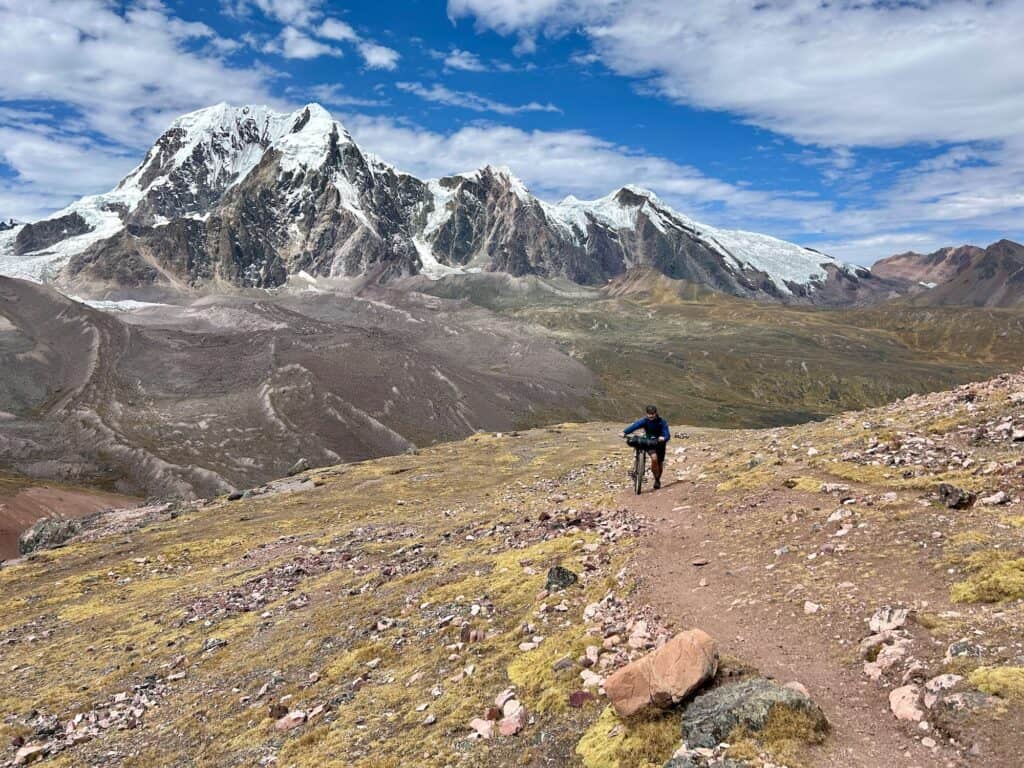

Ausangate at a look
Ausangate is a sacred mountain to the Quechua folks. It’s a part of the Vilcanota mountain vary, which is positioned a couple of hours southeast of Cusco, Peru. The height rises to twenty,945 toes (6,384 meters), making it the best mountain within the Cusco area. Most individuals hike the Ausangate Circuit, however we biked round it (undoubtedly not as in style – we obtained some unusual seems to be and solely noticed one different bikepacker- our new Aussie pal!). The circuit doesn’t take you to the summit of Ausangate, however you may be at about 15,000 – 16,000 toes the whole time.
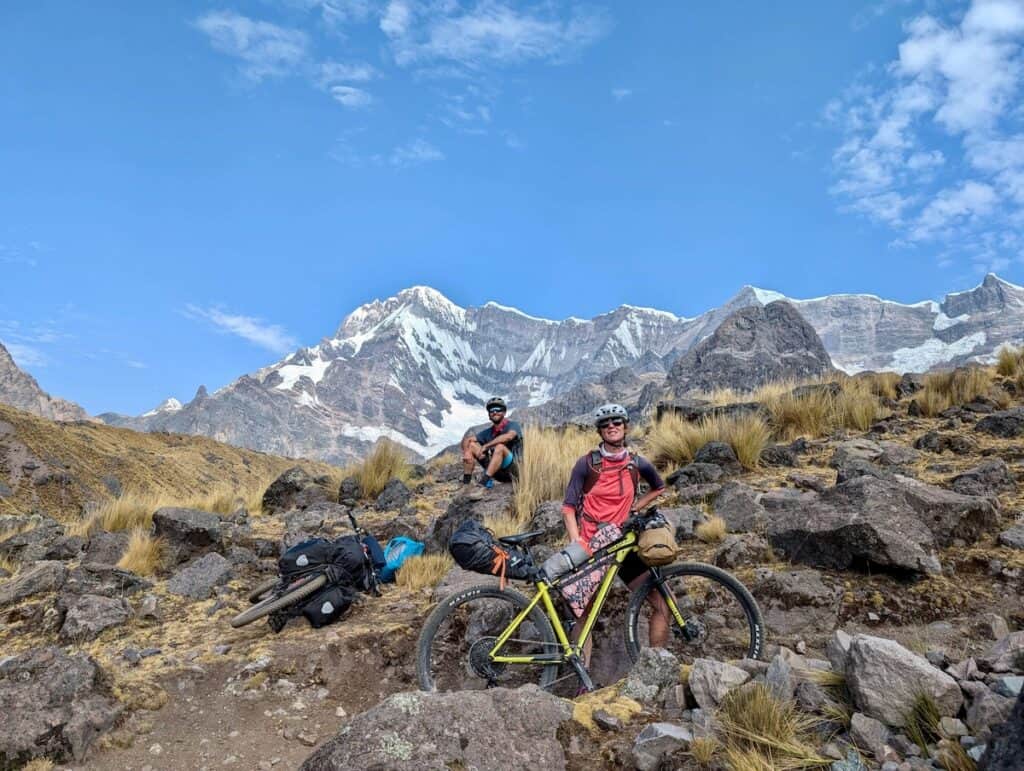

This space is extra distant and fewer crowded than different high-altitude treks in Peru just like the Inca Path to Machu Picchu and even the Huayhuash Path (which can also be alleged to be unbelievable, however even much less appropriate for bikes). I beloved the remoteness and solitude we had on our journey, however not everybody will really feel comfy being so far-off from civilization and providers.
Must you Hike or bike the Ausangate Circuit?
Clearly, we selected to bikepack round Ausangate, however it’s also possible to make it a backpacking journey. We noticed a number of teams of backpackers alongside the best way and, in truth, we ended up hike-a-biking about 50% of our route anyway. Personally, I’m not a lot of a backpacker – I’ll all the time select biking over mountaineering – however if you happen to’re not an skilled rider, backpacking the Ausangante Circuit could also be a greater match.
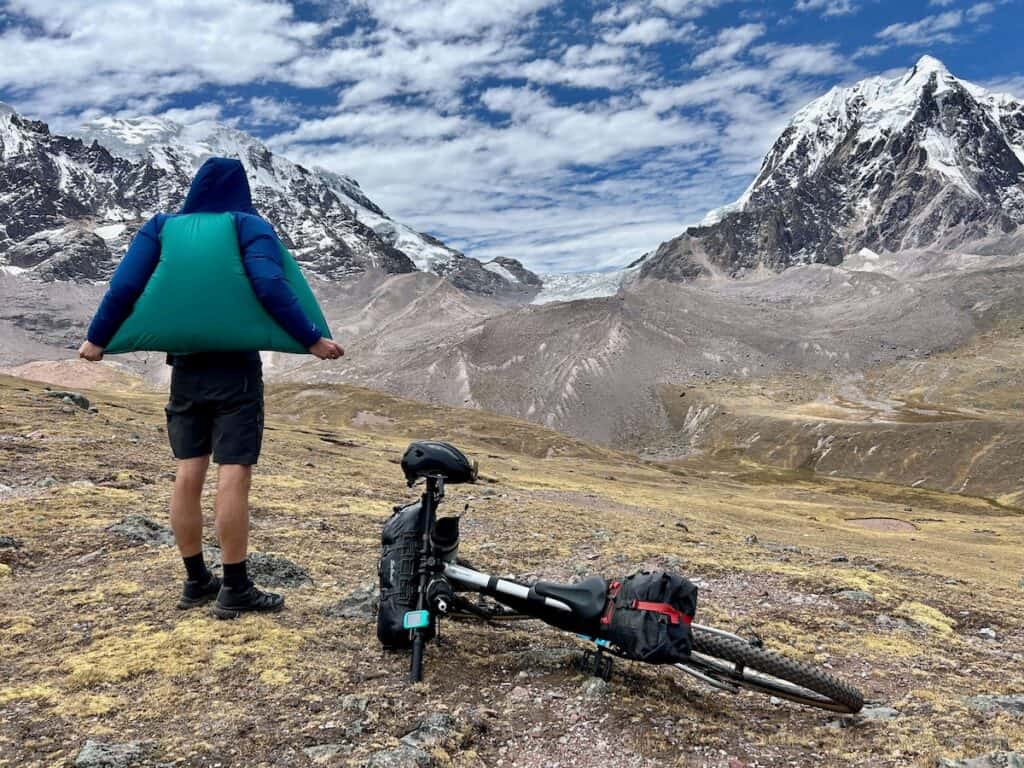

The Route
The route round Ausangante is fairly simple, HOWEVER, it may be difficult to navigate as a result of there are numerous aspect trails going each which means and it’s simple to get caught ‘low’ when you must have stayed ‘excessive’ and vice versa. A GPS navigation system (not your cellphone) is important. I used my Garmin Edge 830, as I do for all my bikepacking journeys, and it has by no means led me astray.
How technical & difficult is it?
It’s laborious. Tougher than I believed it could be. The altitude makes the hike-a-bikes kinda brutal (however value it) and there are a number of climbs which are steep, unfastened, and rocky. It’s possible you’ll be pondering “oh, it’s solely 40 miles or so” however it’s a laborious 40 miles. I extremely advocate aiming to do solely 8-12 miles a day. Don’t underestimate the Ausangate Circuit!
So far as technicality, it’s a combined bag. There are some unbelievable descents which are quick and flowy and there are some soul-sucking climbs up steep and rocky switchbacks. There are additionally pot-holed traverses by means of boggy terrain and easy pedaling throughout open llano. There’s actually a little bit of every thing on this route, which makes it much more fascinating. However as I discussed above, we ended up driving solely about half of of the circuit although we each are very skilled riders.
Much less skilled mountain bikers will discover a number of the descents steep, unfastened, and difficult. Underscore unfastened! If you wish to have enjoyable on this journey, I like to recommend having no less than intermediate mountain biking expertise with some expertise on technical terrain.
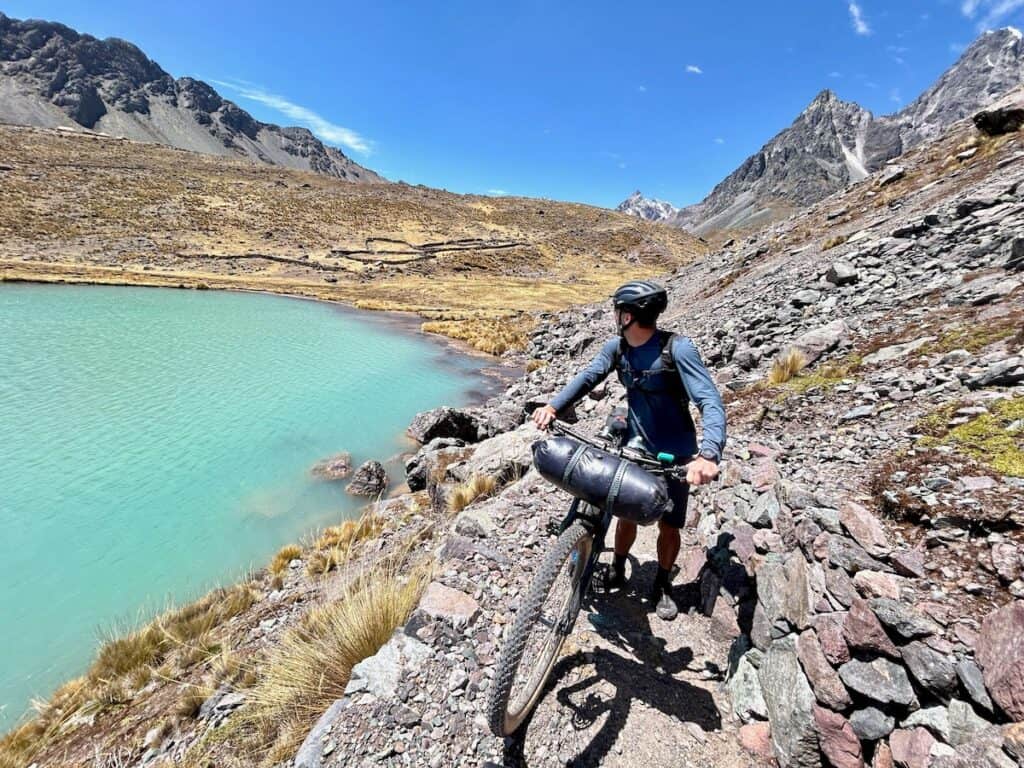

Our Route Recap
Alright, let’s discuss route choices as a result of there are a couple of other ways to do the Ausangate Circuit.
Here’s what we did:
- We obtained a trip with Haku Expeditions from Cusco to Chillca (three hours drive). A number of bikepackers will begin within the city of Pitumarca beneath Chilcca, however we had been tight on time, so we opted to drive as much as Chillca after which end our journey in Pitumarca (which is generally downhill!)
- For navigating the Ausangante Circuit, we largely adopted this route by Sarah Swallow. There are some things I’d change, although, which I’ll dive into beneath.
- We additionally added on Rainbow Mountain. It’s value going to Rainbow Mountain, however I wouldn’t do that route once more. There’s a very steep part by means of a canyon that may be a very laborious hike-a-bike. See beneath for a distinct choice for attending to Rainbow Mountain (which is able to nonetheless be laborious, however not fairly as laborious :).
- From Rainbow Mountain, we descended the principle street all the best way again to Pitumarca the place we stayed the night time after which returned to Cusco the next day through a Haku Expeditions switch.
Tip: The gravel street from Pitumarca to Chillca is a gradual uphill with the potential for lots of vacationer bus visitors heading to Rainbow Mountain. It’s greatest to do it later within the day if you happen to plan on driving it.
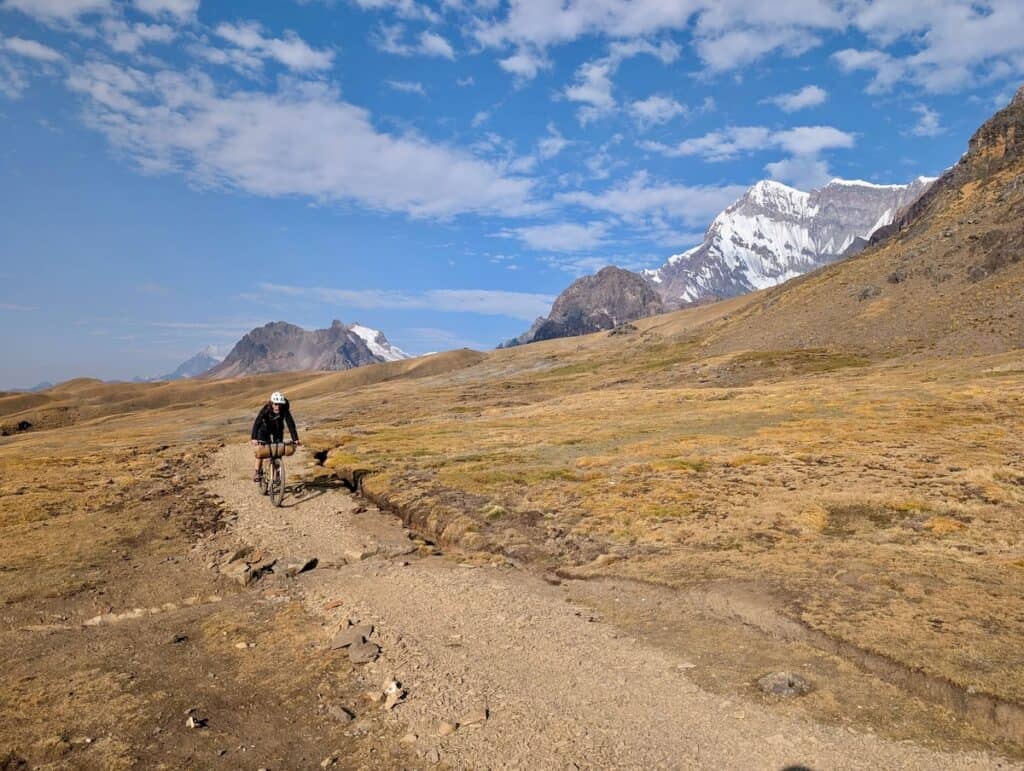

Right here’s a breakdown of our 5-day 4-night journey:
Day 1: We left Cusco round 10am and arrived in Chillca round 1:30pm with a fast cease in Pitumarca for some grab-and-go meals. After organizing our gear and loading our bikes, we began pedaling out of Chillca round 2:30pm. The primary few miles are on doubletrack street, which is an efficient warm-up, however doesn’t actually put together you for what’s to come back over the subsequent 32 miles! (trace trace…) We made it about 7.5 miles to a pleasant open discipline the place we arrange camp by some boulders and watched the solar set over the snow-capped peak of Qullpa Anata.
>> Day 1 stats: 7.58 miles / 981 ft climbing / 1 hr half-hour transferring time / max elevation 15,162 toes
Tip: Pitumarca is the final city with dependable provides for the remainder of the journey.
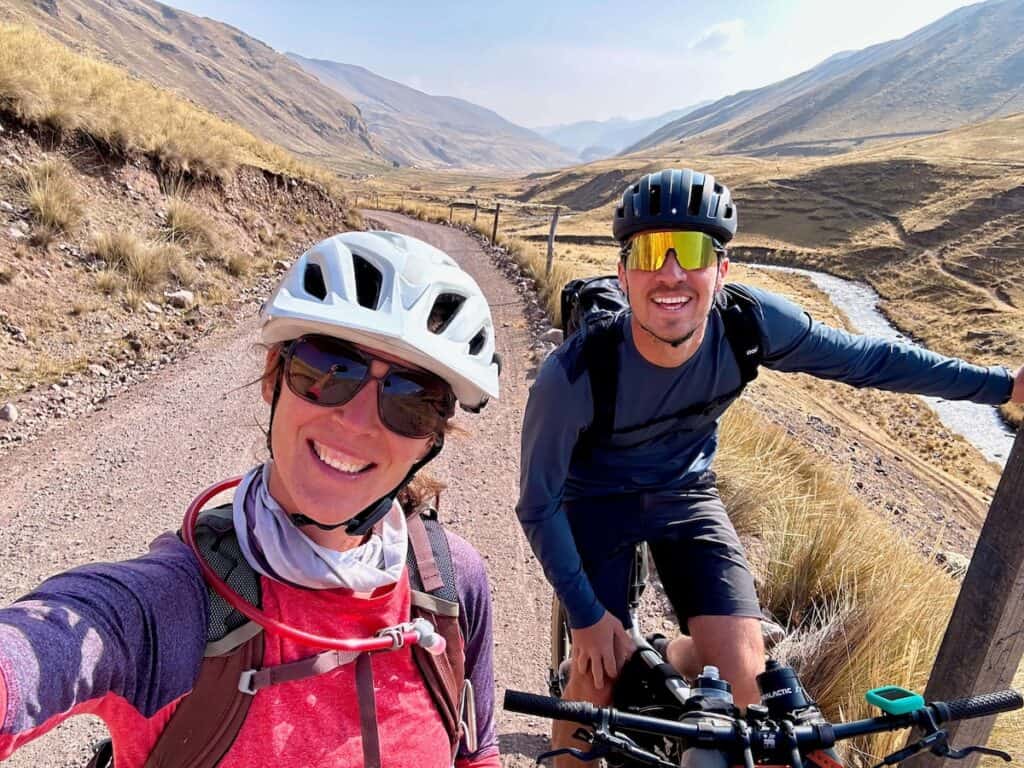

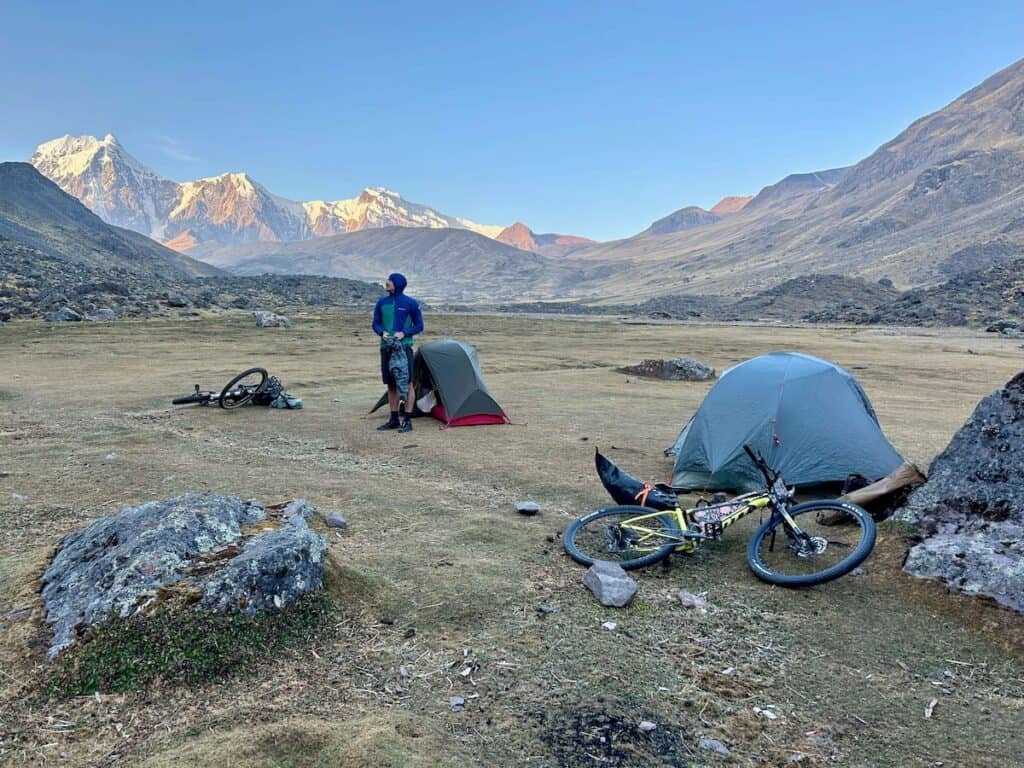

Day 2: Neither of us actually slept effectively (most likely due to the altitude), however we slowly packed up camp, made breakfast, and obtained again on our bikes. Immediately we tackled the largest climb of the route and it was laborious! But in addition stunningly lovely. In response to my GPS, we solely made it 7.5 miles and had a transferring time of two hours, however someway it took us many of the day! Most likely as a result of we took numerous breaks and in addition as a result of the going was slowwww. Anticipate to push your bike up 99% of the climb. However when you make it to the highest of the go, the descent down the opposite aspect is epic. Positively a spotlight of the journey! We camped at a very nice spot on the backside of the descent subsequent to an alpine lake (I extremely advocate leaping in!).
>> Day 2 stats: 7.66 miles / 1,683 ft climbing / 2 hours transferring time (it felt means longer) / max elevation 16,544 toes
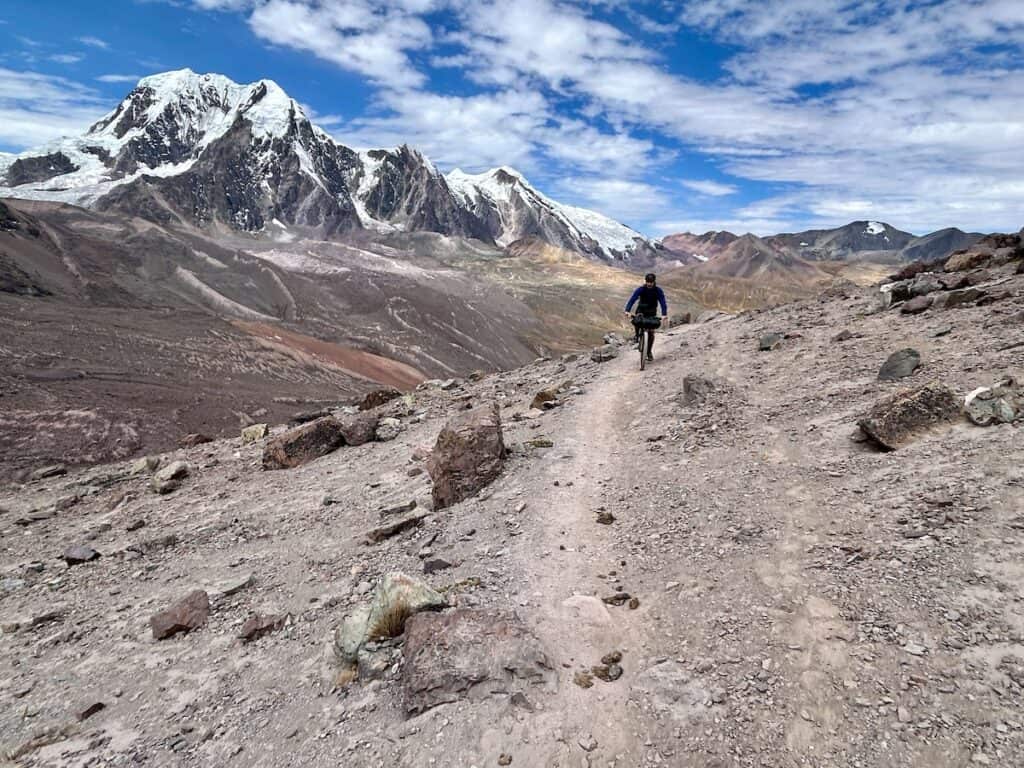

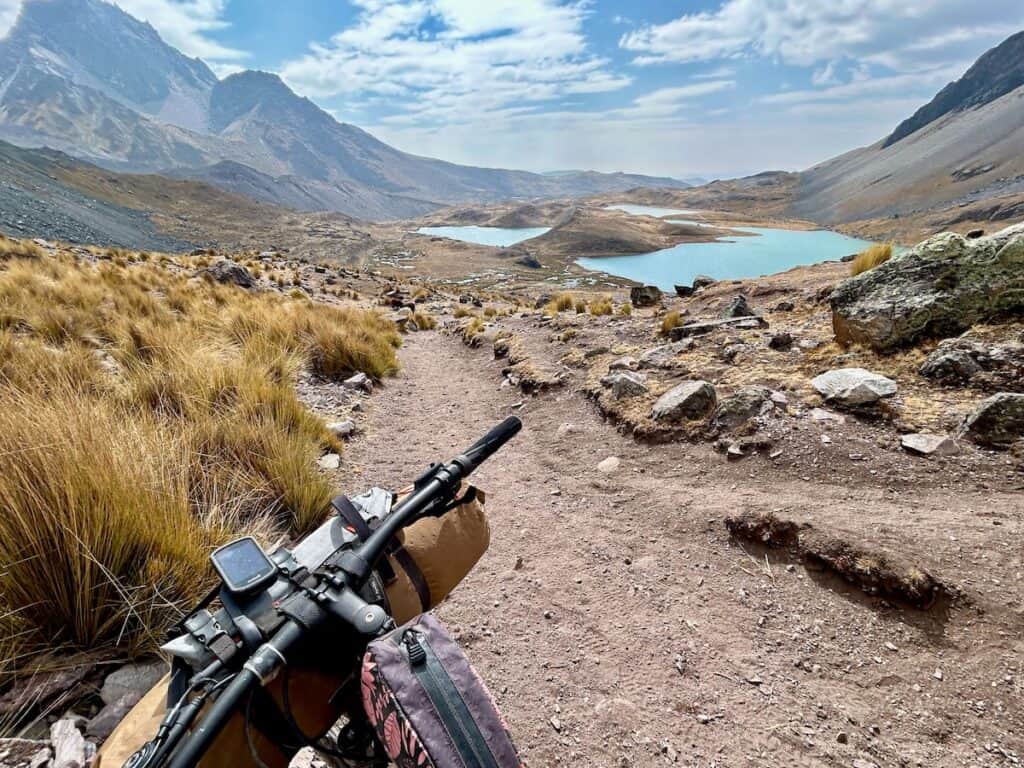

Day 3: I slept terribly, so we had a gradual morning and didn’t find yourself leaving camp till round 10:30am (a mistake in hindsight). I believed it was going to be a neater day, nevertheless it wasn’t! We had one other hike-a-bike climb that was steeper and extra technical than yesterday and navigating the route was additionally a bit trickier. However the views continued to be spectacular. The descent from the highest of the climb was additionally my favourite of the entire journey – quick and flowy with simply the correct quantity of tech on the finish. For tenting, we wished to make it to the free tenting huts at lake Pucacohca. Daylight was waning, however we agreed that we should always push forward, although there was one final powerful hike-a-bike part. We arrived on the huts simply because the solar was setting over the lake, nevertheless it was so good to get out of the wind and arrange our tents contained in the little cabanas (which stored us good and heat!)
>> Day 3 stats: 12 miles / 2,444 toes climbing / 3 hrs 30 minutes transferring time / max elevation 15,711 toes
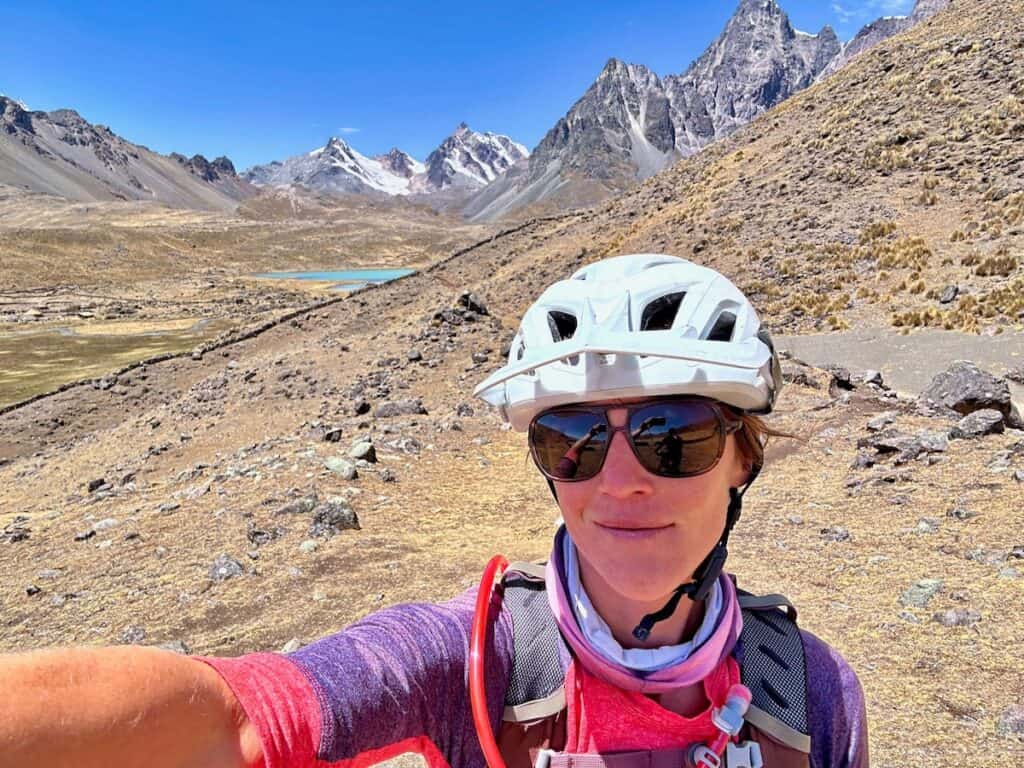

Day 4: We awakened understanding that we had one other huge climb forward of us – the ultimate one of many Ausangate Circuit. This final climb was the best of the three, however we nonetheless hike-a-biked most of it due to the altitude. However the descent down the opposite aspect was tremendous enjoyable and possibly probably the most steep and technical out of all of the descents (I beloved it :). Earlier, we had additionally determined to increase our route another day and head as much as Rainbow Mountain to see its well-known multicolored layers of mineral deposits. We adopted Sarah Swallow’s Rainbow Mountain add-on, however this ended up being a actually powerful hike-a-bike by means of a canyon (see my notes beneath on what I’d do otherwise). Initially, we wished to do many of the climbing as much as Rainbow Mountain right this moment, nevertheless it ended up being an excessive amount of, so we camped at a longtime campsite with little huts and had dinner and performed playing cards with our new Australian bikepacking pal. Positively the precise choice!
>> Day 4 stats: 9.3 miles / 2,139 toes climbing / 2 hrs 50 minutes transferring time / max elevation 16,052 toes
Day 5: I do know I’ve mentioned that each one the climbs on this journey had been difficult, however this last one as much as Rainbow Mountain was the toughest for me. Possibly it was as a result of I hadn’t been sleeping effectively and was exhausted, however this climb kicked my butt. The worst half, too, was that the descent down the opposite aspect was a hike-a-bike, too! It was too steep and unfastened and switchbacked to trip with a loaded bikepacking bike. However… I’ll say that Rainbow Mountain is well worth the struggling to get there – the multicolored striations are actually distinctive aaannndd you may get an image with a llama sporting sun shades. Proper!? From Rainbow Mountain, we bombed down the street (which was lovely) and rejoined the street heading to Pitumarca, which was (fortunately) additionally largely downhill.
>> Day 5 stats: 29 miles / 2,297 toes climbing / 3 hrs 45 minutes transferring time / max elevation 16,579 toes
Tip: We stayed at an important little guesthouse in Pitumarca referred to as Hospedaje Malvin.
What I’d do otherwise
Whereas we did numerous analysis and planning for our Ausangate journey, and total it went actually easily, there are some things I’d do otherwise.
- I’d drop down onto the street main into Upis at round mile 20 on day 3. The route we adopted stayed excessive on the foothills, however navigation was difficult since there wasn’t actually a path to comply with and the driving was fairly stop-and-go. If you may get all the way down to the street, you possibly can have a pleasant pedal into Upis the place there’s a bridge that crosses the river (as an alternative of a sketchy dam crossing) and there’s a small retailer with primary resupplies earlier than the massive hike-a-bike.
- I wouldn’t descend all the best way all the way down to the beginning of the Rainbow Mountain climb. As an alternative, our Aussie bikepacker pal discovered a technique to keep on a better traverse, which lower off the nasty canyon hike-a-bike. It gained’t make the second half of the climb as much as Rainbow Mountain simpler, however no less than it’ll make the primary half a bit much less soul-sucking! (See route beneath)
- If I had an additional day, I’d return to Pitumarca through Valle Rojo from Rainbow Mountain. It’s alleged to be actually lovely and I used to be sort of bummed that we didn’t get to see it. (See route beneath)
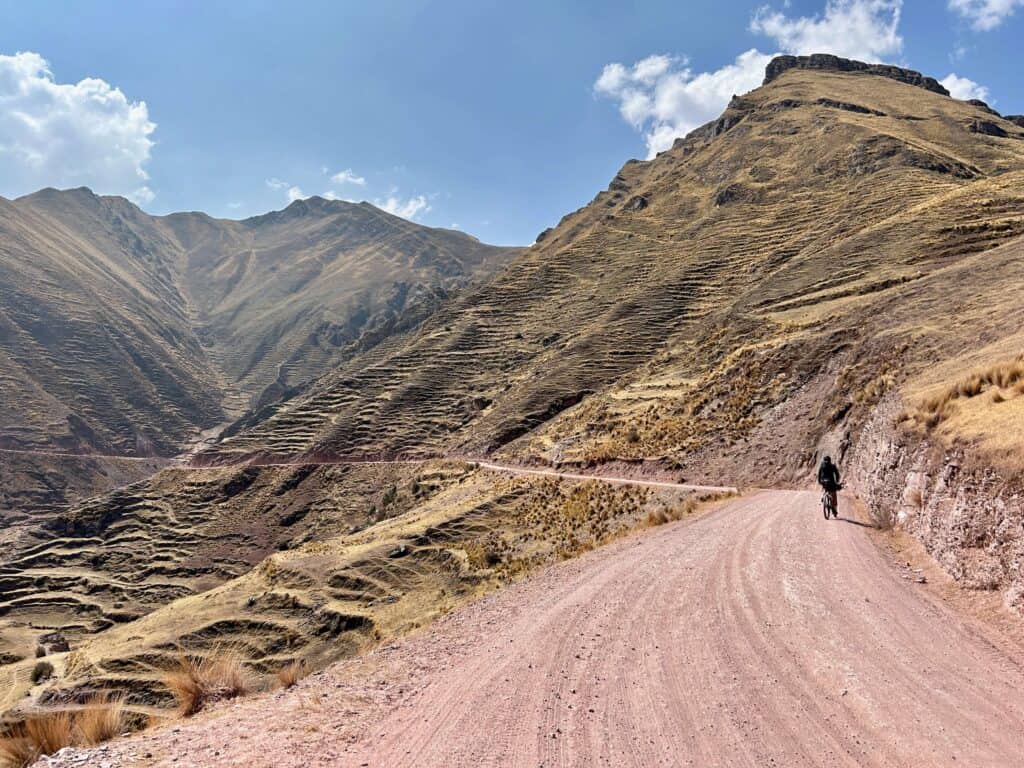

So, with all that in thoughts, listed below are three routes I’d use if I had been to bikepack the Ausangate Circuit once more:
- Ausangate + Valle Rojo: This might be the principle path to comply with. (Notice that I’ve not ridden this whole route – it’s a compilation of what I did trip and what I’d do subsequent time). It has the Upis detour and better traverse to Rainbow Mountain. In case you don’t need to do Valle Rojo, you possibly can both do the ‘fast exit’ beneath or just descend all the way down to Chillca and skip Rainbow Mountain altogether. In case you do Valle Rojo, I’d plan for six days, 5 nights.
- Rainbow Mountain fast exit: In case you don’t have time to do Valle Rojo, that is the quickest means down Rainbow Mountain and again to Pitumarca.
- Pitumarca to Chillca: When you have the time or are counting on transportation, that is the route from Pitumarca to Chillca. Funds an additional day if you happen to begin in Pitumarca.
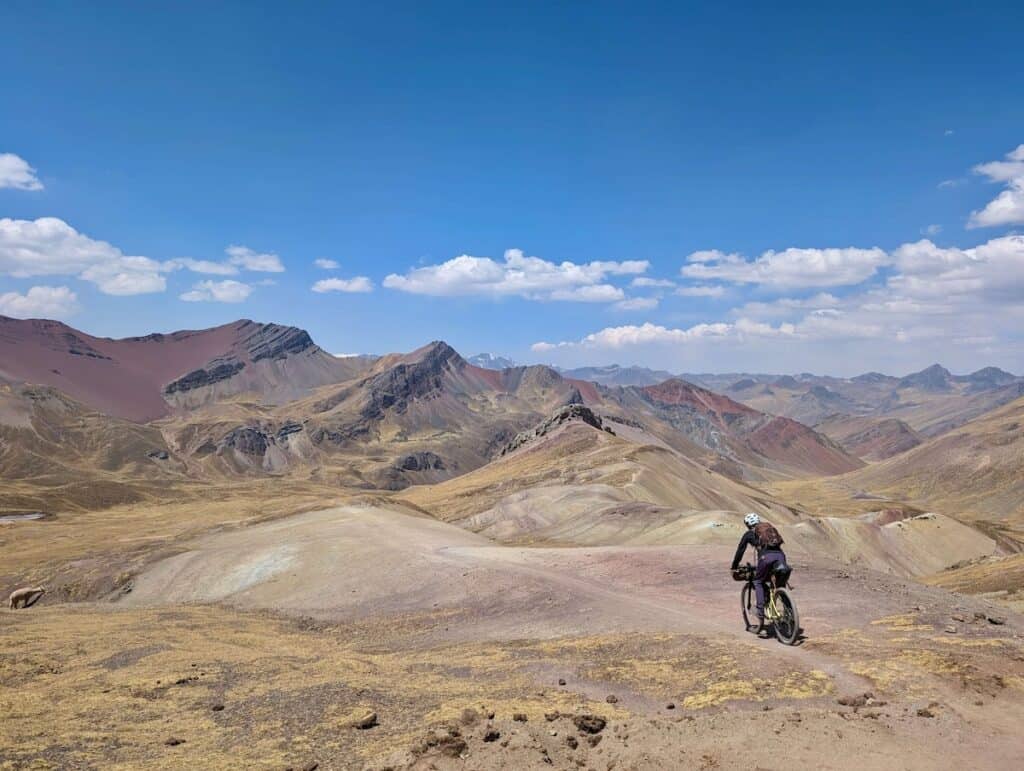

Planning Your Ausangate Journey
When to go: the perfect time to do the Ausangate Circuit is within the dry season – Might by means of October. Remember that that is the southern hemisphere, although, so Might-August is winter and will be actually chilly. We did our journey in early September and had nice climate, however the nights had been nonetheless fairly chilly (beneath freezing). I wouldn’t advocate doing all of your journey within the wet season, which is November by means of April – it could be fairly depressing to be moist and soggy the entire time! This web page has a very good abstract of what to anticipate throughout every month round Ausangate.
Variety of days: We did a 5 day/4 night time journey and it was good for beginning in Chillca, doing the circuit, and including on Rainbow Mountain, then ending in Pitumarca. In case you select to do Valle Rojo, you may need to price range 6 days/5 nights and if you happen to begin in Pitumarca I like to recommend including one other day for that.
Getting there: A number of bikepackers begin in Pitumarca, which is less complicated to get to from Cusco than Chillca, the place we began. There are busses from Cusco to Pitumarca or your can rent non-public transporation. We booked a trip to Chillca from Cusco and from Pitumarca again to Cusco with Haku Expeditions. They’re tremendous skilled, have a motorbike rack on prime of the automotive, and may also help you finalize your journey plans.
Peajes: We’d heard in regards to the peajes earlier than beginning our journey, however we didn’t understand what number of there could be and we had been fairly annoyed with how a lot we paid by the tip of our journey. Peajes are mainly ‘tolls’ that it’s essential pay to go by means of components of the Ausangate Circuit. There is no such thing as a rhyme or purpose for when or the place you’ll encounter an area asking for cash, however be ready to pay no less than 4-5 instances all through your journey. Every peaje prices 20-30 soles per individual ($5-8 USD). I don’t thoughts paying, nevertheless it was fairly irritating that there was no regulation or construction for when or the place we’d encounter a peaje. Convey further Soles.
Water: Water is plentiful alongside the route, so you actually don’t want to hold quite a lot of hours value. You do have to filter and deal with it, although. We introduced a water filter (a Sawyer Squeeze, though I want I’d introduced my GravityWorks as a result of it’s simpler and sooner) and we additionally introduced AquaMira drops to purify the water.
Meals: Plan on packing your whole meals. There are few to no resupplies alongside the whole Ausangate Circuit. We introduced dehydrated meals for dinners, bars for breakfasts, and lighweight snack meals for lunch. The potential locations for resupplies are: a small retailer in Chillca, a small retailer in Upis, and distributors at Rainbow Mountain.
Bike: We each had brief journey hardtails with 2.2-2.3 ish tires. I believed the had been fairly good and I used to be defintely glad to have some entrance suspension. The Aussie bikepacker we met on the circuit had a completely inflexible touring bike and I feel he’d agree that he struggled. A brief journey hardtail is the best way to go.
Gear: Try my bikepacking gear record for a whole stock on what to carry for a bikepacking journey. Particular for the Ausangate Circuit, you’ll need a heat sleeping bag and liner (my NEMO Disco 30 and Sea to Summit Reactor Liner labored nice), a complete instrument and restore package (there’s nobody on the market that might be in a position that will help you in case of a mechanical), a water filter and purification system (see above), and a light-weight bikepacking bag arrange. We each had a handlebar roll, body bag, seat publish bag, and a backpack. I extremely advocate NOT doing panniers – they are going to be a ache within the ass on the hike-a-bikes.
Tenting: It looks as if you possibly can camp just about anyplace on the Ausangate Circuit. There are a couple of ‘established’ campgrounds (don’t count on something fancy), however you don’t have to depend on them for sleeping for the night time. The one campground we did keep at was on the base of Rainbow Mountain. There have been rustic shelters to set our tents up in and bogs. I additionally advocate utilizing the free tenting huts at Lake Pucacocha!
Altitude illness: It is a biggie. We had been a bit crunched for time, so we didn’t have a ton of days to accclimate. We did spend two nights in Cusco (elevation 11,152 toes), however we additionally took Diamox for the whole lot of our journey, which I feel actually helped. Altitude illness must be taken significantly! We had a plan for ‘escape routes’ in case one in all us obtained sick, however fortunately it didn’t come to that. However please do your self a favor and have a plan for coping with the altitude – the entire route is above 15,000 toes and also you WILL really feel it. For me, it affected my sleep largely. However it’s also possible to get actually nauseous, undergo from dangerous complications, and simply really feel fairly horrible total.
Phew, that’s numerous data! I’m the sort of one that does some analysis after which likes to determine issues out as my journey evolves. Hopefully, this information will give a very good place to begin for placing collectively your Ausangate bikepacking journey. It’s an epic route with unbelievable views, powerful climbs, and an actual style of distant Andean solitude. I completely beloved this journey, however simply know that it’s no stroll within the park. Plan effectively and have a tremendous time!
Is the Ausangate Circuit one thing you’d be up for bikepacking (or backpacking?) What questions do you continue to have? Depart a remark beneath!
Was this publish useful?
purchase me a espresso!
I really like writing in regards to the locations I’ve biked and galvanizing you to get out and discover the world by yourself two wheels. If this publish has been useful, think about displaying your thanks with a small donation. It helps me preserve TWW going. Thanks and preserve your wheels spinning!
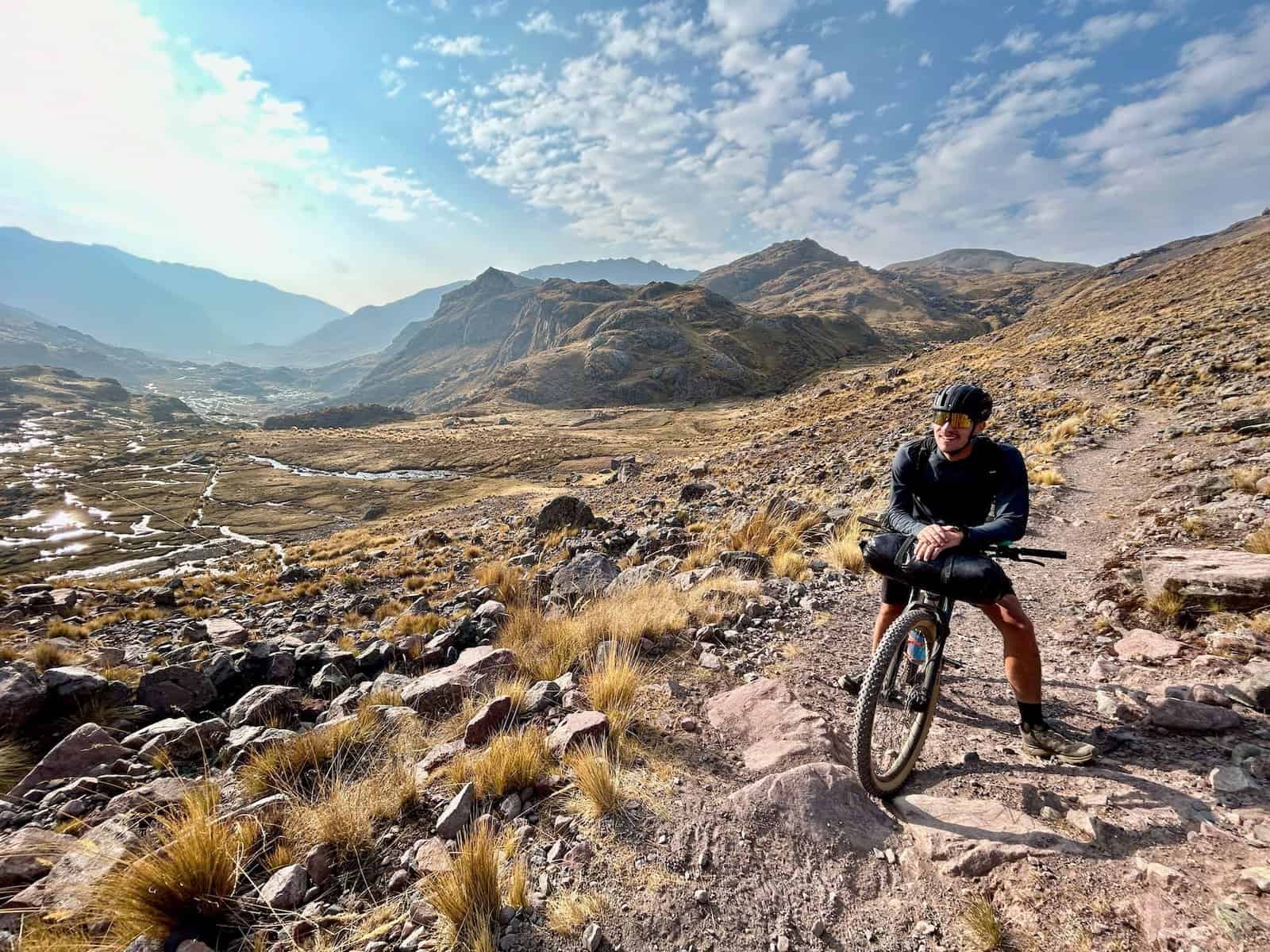
This article provides a lot of useful information for anyone considering the Ausangate Circuit. The personal experiences shared make it easier to relate to the challenges and beauty of the journey.
The detailed description of the route and the tips for planning are very helpful. It seems like a challenging yet rewarding adventure for experienced bikers.
I appreciate the insights about altitude and preparation. It’s crucial to know what to expect before attempting such a demanding bikepacking trip.
The mention of both biking and hiking options is great for those who might not be as experienced on a bike. It opens up more possibilities for different adventurers.
I found the logistics section particularly interesting, especially regarding transportation and supplies. It’s important to be well-prepared for remote areas like Ausangate.